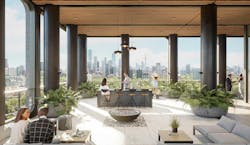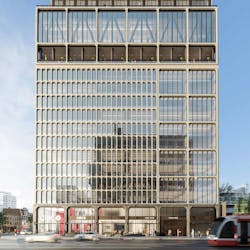Insights from over 300 potential office-to-residential conversions
More than two years from the start of the pandemic, many questions about the office market’s future remain unanswered, but in that time one trend has becoming increasingly clear: tenants are leaving older buildings in favor of newer ones. This accelerated shift has left owners of some aging office buildings with large vacancies and insufficient cash flow to pay back their debt—putting billions of dollars of office-backed loans at risk.
At the start of the pandemic, we began reaching out to our clients and city leaders to understand what was top of mind as the situation continued to unfold. Without exception, our developer and landlord clients asked us for ideas on how to improve leaseability, or modify the existing uses, of their low-grade office assets.
By the fall of 2020, we were ready to road test our office-to-residential dashboard and collaborated with Calgary Economic Development to score buildings in the downtown core. Now, two years on, the city of Calgary has announced the first three downtown office-to-residential conversion projects approved for funding. The city has determined four priorities for the transformation of their city centre: incentivize real estate development, support vibrant initiatives, develop downtown diversity, and improve downtown safety, security, and quality of life.
But it’s no longer just Calgary. With growing office vacancies and declining confidence in Class C buildings in multiple markets across North America, we’ve steadily been working to refine our dashboard. We’re now able to quickly review existing office buildings to determine if they would make good candidates for multifamily conversions, assessing a building in minutes instead of weeks.
Our analysis has grown to over 300 buildings in 25 cities across North America, and through that process we’ve made some interesting discoveries. Our data reveals that only 30% of the buildings scored make for suitable candidates for conversion. Context, building form, location, floor plate size and several other factors all play a crucial role in assessing a building’s aptness for conversion.
That analysis has also revealed something surprising; all the features that result in an unpleasant office, make for a superlative multifamily product. For example, a floor-to-floor height that’s typical of a Class C building is approximately 12 feet. Today, that’s considered oppressively low for an office, but a ceiling height above 9 feet in a residential building is considered luxurious.
While there’s no one size-fits-all solution for converting an under-performing office building into residential, the following examples show how we’ve been unlocking value in markets across North America:
Franklin Tower
Philadelphia, Pa.
Transformed from an outdated office building to a vibrant residential community, PMC Property Group’s Franklin Tower has been reconfigured into a modern, amenity-rich building with residential, commercial, and retail space.
Related:
- Long Beach, Calif., office tower converted to market rate multifamily housing
- Number of office-to-apartment conversion projects has jumped since start of pandemic
- Texaco’s century-old headquarters is now a luxury apartment community
1 St. Clair West
Toronto, Ontario
We were able to unlock the value of a building past its prime on a prominent corner in Toronto’s midtown. Achieving a conversion score of 81%, we proposed a design that met the city’s requirement for office retention and added density with an elegant solution; an overbuild that will add residences, improve the retail and create amenities for both office and residential tenants alike.
The Residences at Rivermark Centre
Baton Rouge
The original design of these Brutalist towers in downtown Baton Rouge makes the project eligible for historic tax credits, incentivizing an adaptive reuse design strategy that revitalizes the heritage of the city. Gensler’s design increases the value and enhances the intent of the original architecture, converting the top twelve floors from offices to 144 residential units.
In the face of changing space needs and a growing housing crisis, cities and building owners are reexamining the value of aging office building stock. With our new approach, we have the ability to quickly determine in minutes whether these stranded assets are suitable for conversion—and what a potential change of use could look like in practice.
For media inquiries, email [email protected].
About the Author
Gensler
A global design firm with more than 5,000 practitioners networked across five continents, Gensler features insights and opinions of architects and designers on how design innovation makes cities more livable, work smarter, and leisure more engaging. Our contributors write about projects of every scale, from refreshing a retailer’s brand to planning a new urban district, all the while explaining how great design can optimize business performance and human potential. For more thought leadership and blog content, visit our Research & Insight page. Follow us on Facebook, LinkedIn, and Twitter.


